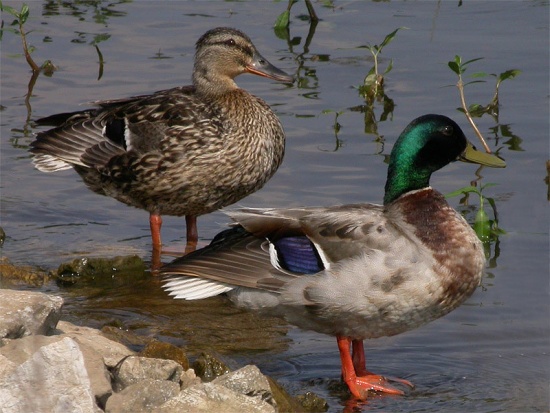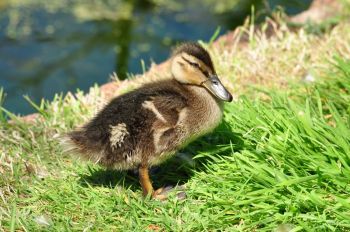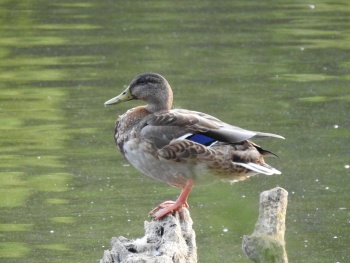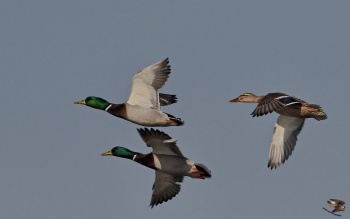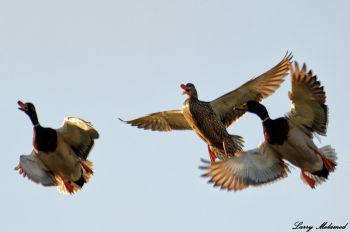- Anas platyrhynchos
Identification
Male 55–70 cm (21¾-27½ in), female 50–60 cm (19¾-23½ in)
Drake
- Green head separated from a brown breast by a white ring.
- Yellow bill.
- Curly central tail feathers.
Female
- Streaked brown body
- Brown bill with a variable amount of orange around the edge
Both have a white-edged blue speculum
Eclipse male resembles female, but retains yellow bill.
Has been domesticated and many unusual Mallards are either escaped domestics or hybrids with such birds.
Distribution
The most abundant and widespread duck in the region breeding throughout Europe from Iceland and northern Scandinavia south to the Mediterranean, on some Mediterranean islands and throughout Turkey. Rare and local breeder in North-West Africa and Cyprus.
Resident or partial migrant in Iceland, the British Isles and Continental Europe from Spain east to the Baltic States and south to Greece and Turkey. Summer visitor to much of Scandinavia and Russia.
Vagrant north to Svalbard and south to the Azores where has bred.
Also in North America, breeding in the USA and Canada, wintering to Mexico and the Carribean.
Taxonomy
This is a polytypic species[1] consisting of 2 subspecies.
Formerly considered conspecific with Mexican Duck.
Subspecies
- A. p. platyrhynchos:
- A. p. conboschas:
- Coastal south-western Greenland
Habitat
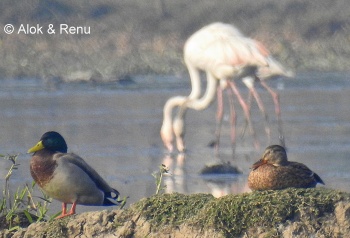
Photo © by Alok Tewari
Greater Flamingo in the BG, Nazfgarh Wetland and Marshes, Delhi-Gurgaon Border, India, 18 January 2018
Virtually any kind of freshwater from small ponds on farms and in town parks up to the largest reservoirs, and also swamps and marshes.
In winter especially, also on estuaries and sometimes on sheltered seas.
Behaviour
Diet
Diet includes insects, seed, roots, grain either whilst dabbling or on land.
Breeding
Nest is a bowl of grass lined with feathers and down, usually on the ground close to water and concealed among vegetation. Clutch of usually 9–13 grey-green or bluish eggs (4–18 max) are laid at one-day intervals.
Vocalisation
Male: Quiet kwack, nasally rheb.
Female: Loud traditional quack
Listen a voice clip
Movements
Partially migratory, northernmost breeding populations generally winter much further South.
References
- Clements, J. F., T. S. Schulenberg, M. J. Iliff, S. M. Billerman, T. A. Fredericks, J. A. Gerbracht, D. Lepage, B. L. Sullivan, and C. L. Wood. 2021. The eBird/Clements checklist of Birds of the World: v2021. Downloaded from https://www.birds.cornell.edu/clementschecklist/download/
- Drilling, N., R. D. Titman, and F. McKinney (2020). Mallard (Anas platyrhynchos), version 1.0. In Birds of the World (S. M. Billerman, Editor). Cornell Lab of Ornithology, Ithaca, NY, USA. https://doi.org/10.2173/bow.mallar3.01
- Carboneras, C. & Kirwan, G.M. (2020). Mallard (Anas platyrhynchos). In: del Hoyo, J., Elliott, A., Sargatal, J., Christie, D.A. & de Juana, E. (eds.). Handbook of the Birds of the World Alive. Lynx Edicions, Barcelona. (retrieved from https://www.hbw.com/node/52875 on 17 April 2020).
Recommended Citation
- BirdForum Opus contributors. (2025) Mallard. In: BirdForum, the forum for wild birds and birding. Retrieved 24 April 2025 from https://www.birdforum.net/opus/Mallard
External Links
GSearch checked for 2020 platform.1




